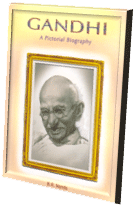
P.O. SEVAGRAM, DIST.WARDHA 442102, MS, INDIA. Phone: 91-7152-284753
FOUNDED BY MAHATMA GANDHI IN 1936
BIOGRAPHY OF GANDHI
GANDHI - A PICTORIAL BIOGRAPHY
by Shri B. R. Nanda

GANDHI
- A PICTORIAL BIOGRAPHY
Shri B. R. Nanda
Table of Contents
- About Gandhi
- Childhood
- Off To England
- Briefless Barrister
- In The 'Dark Continent'
- The Young Politician
- Satyagraha Struggle In South Africa
- The Making Of The Mahatma
- Return To India
- Gandhi's Ashram
- World War I
- Rowlatt Bills
- Nonviolent Non-cooperation
- Arrest And Imprisonment
- Reaction And Recovery
- Declaration Of Complete Independence
- Gandhi-Irwin Pact
- Round Table Conference
- In London
- Resumption Of Struggle
- Campaign Against Untouchability
- A New Deal For The Village
- The New Constitution
- Hindu-Muslim Antagonism
- Nonviolence In A Violent World
- Cripps Mission
- "Quit India"
- Simla Conference
- Cabinet Mission
- Communal Conflagration
- Partition of India
- Mission of Peace
- The End
- Gandhi and Nonviolence
About This Book
This is the first pictorial biography of Gandhi in which the narrative-concise, readable and incisive is illustrated with contemporary photographs and facsimiles of letters, newspaper reports and cartoons, adding up to a fascinating flash-back on the life of Mahatma Gandhi and the struggle for Indian freedom led by him. There is a skilful matching in this book of text and illustrations, of description and analysis and of concrete detail and large perspective. This pictorial biography will revive many memories in those who have lived through the Gandhian era; it should also be of interest to the post-independence generation.
About Author
Shri B. R. Nanda - former Director, Nehru Memorial Museum and Library, New Delhi. His full-scale biography of Mahatma Gandhi has been published in India, Britain and the U.S.A. and translated into French, Spanish, Italian and several other languages
Chapter-19 : Resumption Of Struggle
On December 28, 1931, Gandhi landed at Bombay. Within a week he was in jail and civil disobedience was resumed; the Indian National Congress was out-lawed and the Gandhi-Irwin Pact had gone to pieces.
While Gandhi was on the high seas, the arrests of Jawaharlal Nehru and Abdul Ghaffar Khan, two of his ablest lieutenants, had created a crisis. Most of the British officers in India had really been unhappy at the rapprochement which Irwin had attempted with Gandhi; they won over his successor Lord Willingdon to a tougher policy towards the Mahatma. Gandhi sought an interview with the Viceroy to smooth away difficulties but was rebuffed. The Government of India was not in a conciliatory mood. Indeed it struck with lightning speed to deprive the Indian National Congress of its leaders, organization and resources. Despite the suddenness and severity of the repression, 61,551 persons came forward and were convicted for civil disobedience in the first nine months of the movement in 1932; this figure was a little higher than that of the earlier campaign in 1930-31.